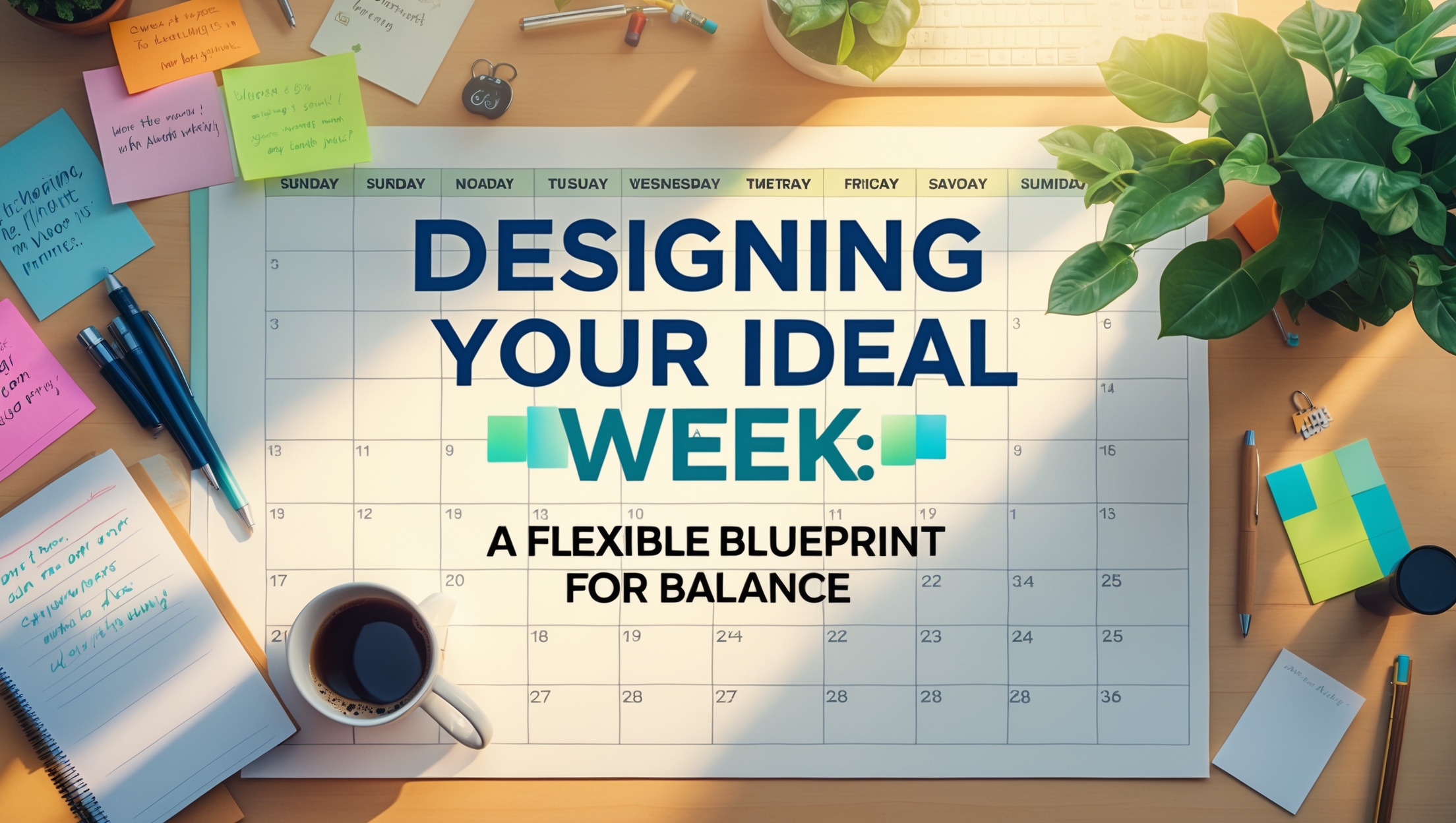Show up for your goals—without burning out
If your calendar feels like a chaotic to-do list and your days blur together in a mix of overcommitment and exhaustion, you’re not alone. Many of us live reactively, letting emails, meetings, and obligations dictate how we spend our time. But what if you could design your week—intentionally, proactively—to reflect your goals, energy, and personal rhythm?
Welcome to the idea of the Ideal Week: a flexible template that helps you build structure around what matters most. It’s not about filling every hour. It’s about creating a rhythm you can return to—one that brings focus, rest, creativity, and balance into your life.
Let’s walk through how to design your own ideal week—step by step.
Step 1: Zoom Out Before You Zoom In
Before you start blocking off your calendar, step back and ask a few key questions:
- What are my priorities right now? (Work, health, family, creativity?)
- What activities leave me feeling energized?
- What drains me, and can I reduce or eliminate those things?
- When do I naturally feel focused, creative, or tired during the day?
This reflection will help you match your weekly flow to your actual needs and energy levels—not just the clock or social expectations.
Step 2: Break Your Week into Zones
Think of your week like a puzzle, and your time blocks as the pieces. Here are common “zones” to consider as you sketch out your blueprint:
- Deep Work / Focus Time: Mornings are often best for this—use them for writing, thinking, coding, or strategic work.
- Meetings / Collaboration: Group these together in specific blocks so they don’t fragment your day.
- Admin / Maintenance: Emails, errands, scheduling, chores. Batch them to avoid constant context switching.
- Creative Flow: Set aside unstructured time for journaling, music, art, or idea generation.
- Exercise / Movement: Anchor your physical energy. Whether it’s yoga, walking, or strength training, put it in the calendar.
- Personal Time: Include solo time, rest, and activities that nourish you.
- Social Time: Calls with friends, dinners, or community activities—schedule them like you would a meeting.
- Buffer Zones: Leave space between activities. Don’t underestimate the power of transition time.
No two ideal weeks look the same. Some people front-load their week and keep Fridays light. Others thrive with short, focused days and long breaks. Your rhythm is yours to discover.
Step 3: Choose a Visual Tool That Works for You
Your ideal week becomes more real when it’s visible. You can map it using:
- A paper planner with weekly spreads
- A Google Calendar or app like Notion
- A whiteboard or wall chart in your workspace
- Printable templates (many are free online)
Color-code your time blocks if that helps: maybe blue for focus, green for wellness, yellow for social, and so on.
Importantly, remember this is a template, not a rigid schedule. Life will throw curveballs. The ideal week is your default, a home base to return to when things feel off-track.
Step 4: Align Your Real Week with Your Ideal
Now, compare your actual week to your ideal one:
- Are you spending enough time on what matters most to you?
- Are your most productive hours being used for focused work or getting lost in distractions?
- Are there areas where you can delegate, reduce, or reschedule?
Adjust gradually. You don’t need a perfect week to benefit from this practice—just more intention than before.
Step 5: Build In Flexibility
An ideal week isn’t about perfection. It’s a rhythm, not a rule. Life is unpredictable—sick days, surprises, tech issues, or a spontaneous trip with a friend. That’s okay.
Use your ideal week to bounce back, not beat yourself up. When something throws you off, simply return to the next available block. Flexibility is a feature, not a flaw.
Bonus Tips
- Plan weekly, not daily: On Sundays or Mondays, look at the week ahead and make micro-adjustments.
- Use energy matching: Do hard things when you’re sharp, and save light tasks for low-energy times.
- Protect your anchors: These might be morning routines, workouts, family dinners, or creative hours. Keep them sacred.
- Schedule joy: Don’t let rest and fun become afterthoughts. They belong in your calendar, too.
Your Week, Designed by You
In a world of noise and demands, designing your ideal week is a quiet act of power. It says: I get to choose what matters. It invites flow instead of friction, intention instead of overwhelm.
And while you may not stick to your ideal week perfectly, the practice of planning it teaches you something profound: you can shape your time, rather than letting it shape you.
Try it for a few weeks. See what shifts. You might just find a rhythm that feels like home.





